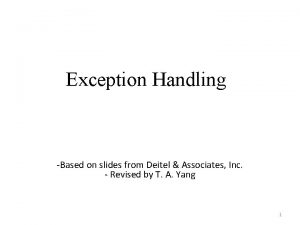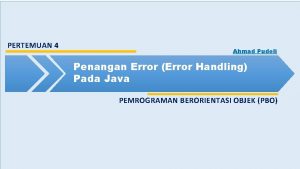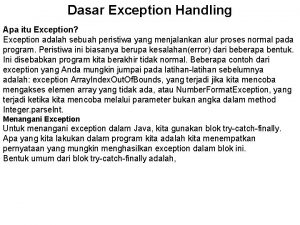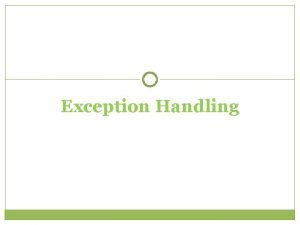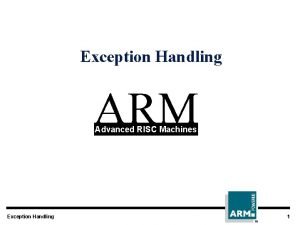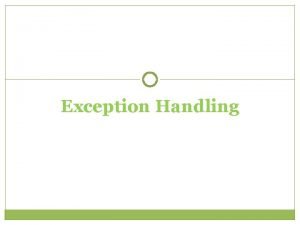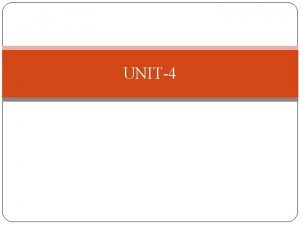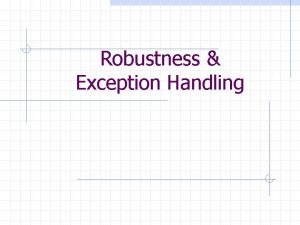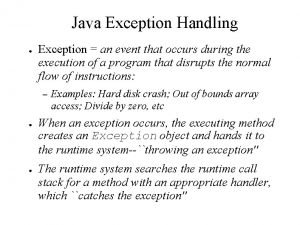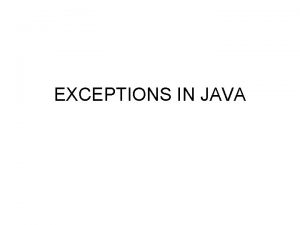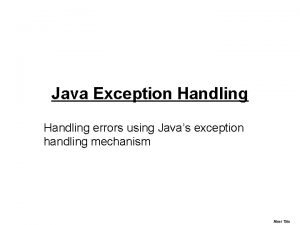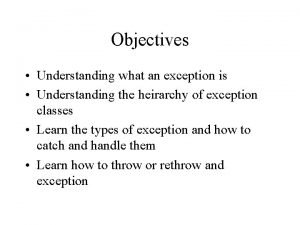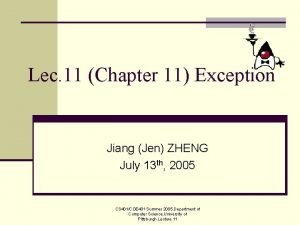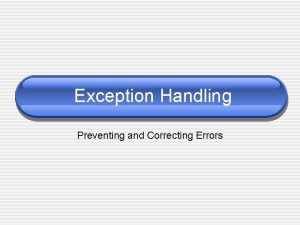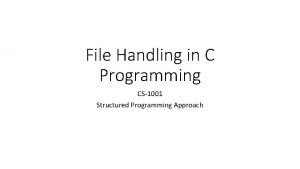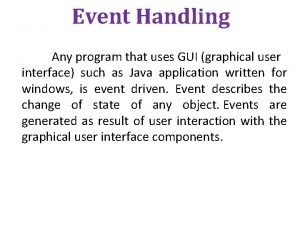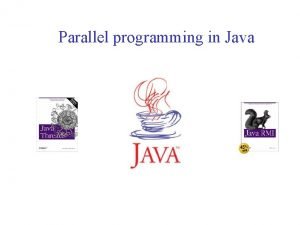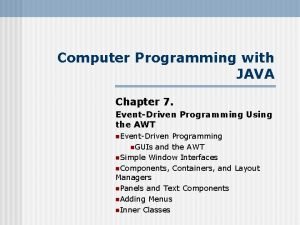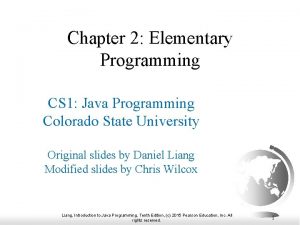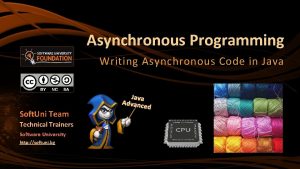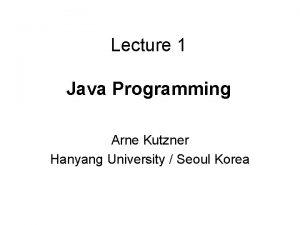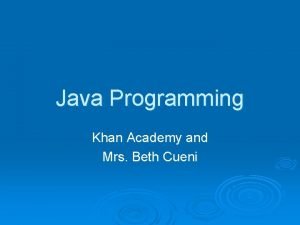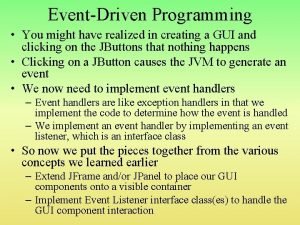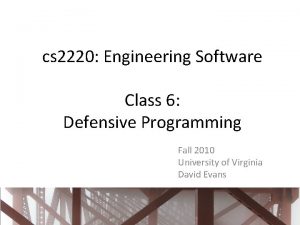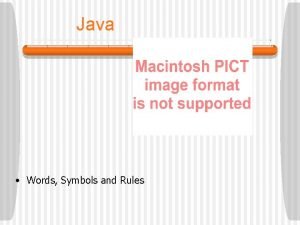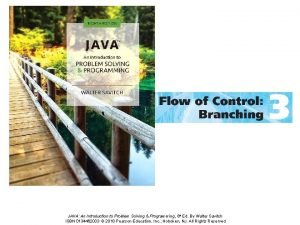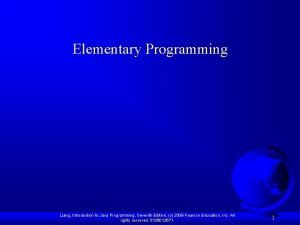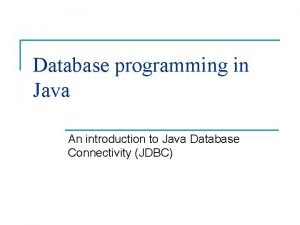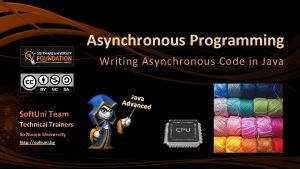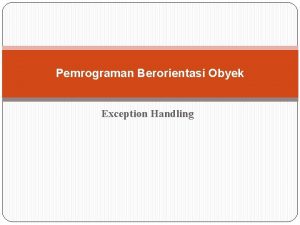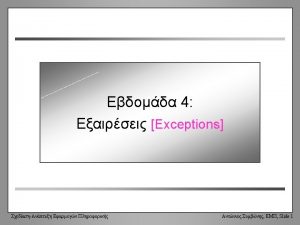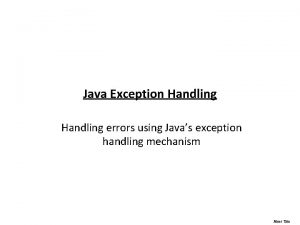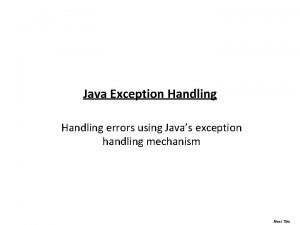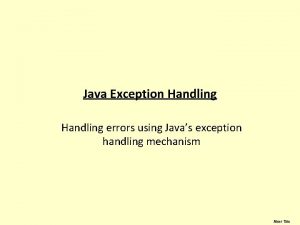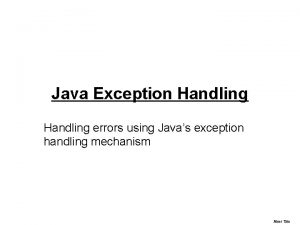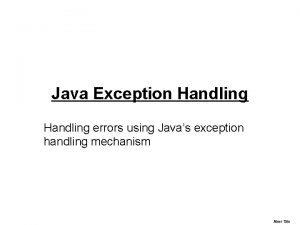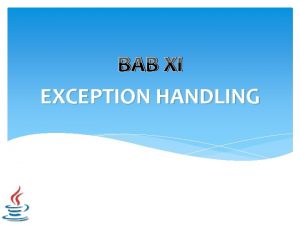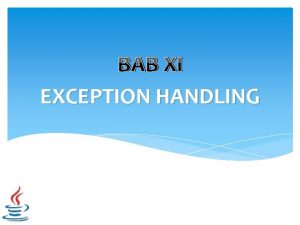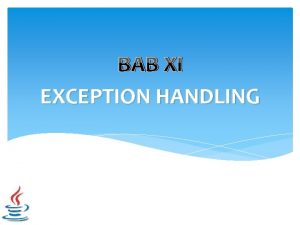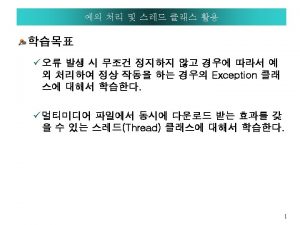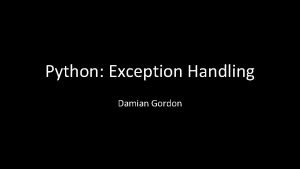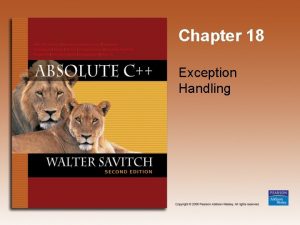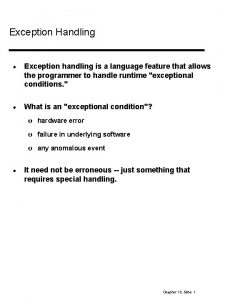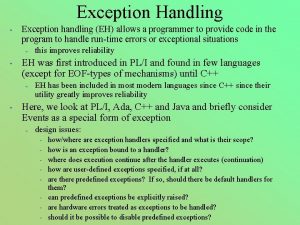Java Programming Exception Handling The exception handling is


















![Solution by exception handling class Simple{ public static void main(String args[]){ try{ int data=50/0; Solution by exception handling class Simple{ public static void main(String args[]){ try{ int data=50/0;](https://slidetodoc.com/presentation_image_h2/17827f34d7f99c8385d36a680d99bbed/image-19.jpg)

![class Excep 4{ public static void main(String args[]){ try{ int a[]=new int[5]; a[5]=30/0; } class Excep 4{ public static void main(String args[]){ try{ int a[]=new int[5]; a[5]=30/0; }](https://slidetodoc.com/presentation_image_h2/17827f34d7f99c8385d36a680d99bbed/image-21.jpg)
![class Excep 4{ public static void main(String args[]){ try{ int a[]=new int[5]; a[5]=30/0; } class Excep 4{ public static void main(String args[]){ try{ int a[]=new int[5]; a[5]=30/0; }](https://slidetodoc.com/presentation_image_h2/17827f34d7f99c8385d36a680d99bbed/image-22.jpg)


![class Excep 6{ public static void main(String args[]){ try{ System. out. println("going to divide"); class Excep 6{ public static void main(String args[]){ try{ System. out. println("going to divide");](https://slidetodoc.com/presentation_image_h2/17827f34d7f99c8385d36a680d99bbed/image-25.jpg)


















- Slides: 43

Java Programming Exception Handling

• The exception handling is one of the powerful mechanism provided in java. It provides the mechanism to handle the runtime errors so that normal flow of the application can be maintained. • In this page, we will know about exception, its type and the difference between checked and unchecked exceptions.

Exception • Dictionary Meaning: Exception is an abnormal condition. • In java, exception is an event that disrupts the normal flow of the program. It is an object which is thrown at runtime. • Exception Handling is a mechanism to handle runtime errors.

Advantage of Exception Handling • The core advantage of exception handling is that normal flow of the application is maintained. Exception normally disrupts the normal flow of the application that is why we use exception handling. • Let's take a scenario: statement 1; statement 2; statement 3; statement 4; statement 5; statement 6; statement 7; statement 8; statement 9; statement 10;

• Suppose there is 10 statements in your program and there occurs an exception at statement 5, rest of the code will not be executed i. e. statement 6 to 10 will not run. If we perform exception handling, rest of the exception will be executed. That is why we use exception handling.

Hierarchy of Exception classes

Types of Exception: • There are mainly two types of exceptions: checked and unchecked where error is considered as unchecked exception. The sun microsystem says there are three types of exceptions: 1. Checked Exception 2. Unchecked Exception 3. Error

What is the difference between checked and unchecked exceptions ? • 1)Checked Exception • The classes that extend Throwable class except Runtime. Exception and Error are known as checked exceptions e. g. IOException, SQLException etc. Checked exceptions are checked at compile-time. • 2)Unchecked Exception: • The classes that extend Runtime. Exception are known as unchecked exceptions e. g. Arithmetic. Exception, Null. Pointer. Exception, Array. Index. Out. Of. Bounds. Exception etc. Unchecked exceptions are not checked at compile-time rather they are checked at runtime. • 3)Error • Error is irrecoverable e. g. Out. Of. Memory. Error, Virtual. Machine. Error, Assertion. Error etc.

Common scenarios of Exception Handling where exceptions may occur • There are given some scenarios where unchecked exceptions can occur. They are as follows: • 1) Scenario where Arithmetic. Exception occurs • If we divide any number by zero, there occurs an Arithmetic. Exception. • int a=50/0; //Arithmetic. Exception

2) Scenario where Null. Pointer. Exception occurs • If we have null value in any variable, performing any operation by the variable occurs an Null. Pointer. Exception. String s=null; System. out. println(s. length()); //Null. Pointer. Exceptio n

3) Scenario where Number. Format. Exception occurs • The wrong formatting of any value, may occur Number. Format. Exception. Suppose I have a string variable that have characters, converting this variable into digit will occur Number. Format. Exception. String s="abc"; int i=Integer. parse. Int(s); //Number. Format. Exception

4) Scenario where Array. Index. Out. Of. Bounds. Exception occurs • If you are inserting any value in the wrong index, it would result Array. Index. Out. Of. Bounds. Exception as shown below: int a[]=new int[5]; a[10]=50; //Array. Index. Out. Of. Bounds. Exception

Use of try-catch block in Exception handling: • Five keywords used in Exception handling: – try – catch – finally – throws

try block • Enclose the code that might throw an exception in try block. It must be used within the method and must be followed by either catch or finally block. • Syntax of try with catch block try{. . . }catch(Exception_class_Name reference){}

Syntax of try with finally block try{. . . }finally{}

catch block • Catch block is used to handle the Exception. It must be used after the try block. • Problem without exception handling class Simple{ public static void main(String args[]){ int data=50/0; System. out. println("rest of the code. . . "); } }

What happens behind the code int a=50/0;

• The JVM firstly checks whether the exception is handled or not. If exception is not handled, JVM provides a default exception handler that performs the following tasks: – Prints out exception description. – Prints the stack trace (Hierarchy of methods where the exception occurred). – Causes the program to terminate. • But if exception is handled by the application programmer, normal flow of the application is maintained i. e. rest of the code is executed.
![Solution by exception handling class Simple public static void mainString args try int data500 Solution by exception handling class Simple{ public static void main(String args[]){ try{ int data=50/0;](https://slidetodoc.com/presentation_image_h2/17827f34d7f99c8385d36a680d99bbed/image-19.jpg)
Solution by exception handling class Simple{ public static void main(String args[]){ try{ int data=50/0; }catch(Arithmetic. Exception e){System. out. println(e); } System. out. println("rest of the code. . . "); } }

Multiple catch block: • If you have to perform different tasks at the occrence of different Exceptions, use multple catch block. • Rule: At a time only one Exception is occured and at a time only one catch block is executed. • Rule: All catch blocks must be ordered from most specific to most general i. e. catch for Arithmetic. Exception must come before catch for Exception.
![class Excep 4 public static void mainString args try int anew int5 a5300 class Excep 4{ public static void main(String args[]){ try{ int a[]=new int[5]; a[5]=30/0; }](https://slidetodoc.com/presentation_image_h2/17827f34d7f99c8385d36a680d99bbed/image-21.jpg)
class Excep 4{ public static void main(String args[]){ try{ int a[]=new int[5]; a[5]=30/0; } catch(Arithmetic. Exception e){ System. out. println("task 1 is completed"); } catch(Array. Index. Out. Of. Bounds. Exception e){ System. out. println("task 2 completed"); } catch(Exception e){ System. out. println("common task completed"); } System. out. println("rest of the code. . . "); } }
![class Excep 4 public static void mainString args try int anew int5 a5300 class Excep 4{ public static void main(String args[]){ try{ int a[]=new int[5]; a[5]=30/0; }](https://slidetodoc.com/presentation_image_h2/17827f34d7f99c8385d36a680d99bbed/image-22.jpg)
class Excep 4{ public static void main(String args[]){ try{ int a[]=new int[5]; a[5]=30/0; } catch(Exception e){System. out. println("common task completed"); } catch(Arithmetic. Exception e){System. out. println("task 1 is completed"); } catch(Array. Index. Out. Of. Bounds. Exception e) { System. out. println("task 2 completed"); } } } System. out. println("rest of the code. . . ");

Nested try block: • try block within a try block is known as nested try block. • Why use nested try block? Sometimes a situation may arise where a part of a block may cause one error and the entire block itself may cause another error. In such cases, exception handlers have to be nested

Syntax: . . try { statement 1; statement 2; } catch(Exception e) { }. .
![class Excep 6 public static void mainString args try System out printlngoing to divide class Excep 6{ public static void main(String args[]){ try{ System. out. println("going to divide");](https://slidetodoc.com/presentation_image_h2/17827f34d7f99c8385d36a680d99bbed/image-25.jpg)
class Excep 6{ public static void main(String args[]){ try{ System. out. println("going to divide"); int b =39/0; }catch(Arithmetic. Exception e){ System. out. println(e); } try{ int a[]=new int[5]; a[5]=4; }catch(Array. Index. Out. Of. Bounds. Exception e){ System. out. println(e); } System. out. println("other statement); }catch(Exception e){System. out. println("handeled"); } System. out. println("normal flow. . "); } }

finally block • The finally block is a block that is always executed. It is mainly used to perform some important tasks such as closing connection, stream etc.


• Note: Before terminating the program, JVM executes finally block(if any). • Note: finally must be followed by try or catch block.

Why use finally block? • finally block can be used to put "cleanup" code such as closing a file, closing connection etc.

case 1 • Program in case exception does not occur class Simple{ public static void main(String args[]){ try{ int data=25/5; System. out. println(data); } catch(Null. Pointer. Exception e){System. out. println(e); } finally{System. out. println("finally block is always executed"); } System. out. println("rest of the code. . . "); } } Output: 5 finally block is always executed rest of the code. . .

case 2 • Program in case exception occured but not handled class Simple{ public static void main(String args[]){ try{ int data=25/0; System. out. println(data); } catch(Null. Pointer. Exception e){System. out. println(e); } finally{System. out. println("finally block is always executed"); } System. out. println("rest of the code. . . "); } } Output: finally block is always executed Exception in thread main j ava. lang. Arithmetic. Exception: / by zero

case 3 • Program in case exception occured and handled class Simple{ public static void main(String args[]){ try{ int data=25/0; System. out. println(data); } catch(Arithmetic. Exception e){System. out. println(e); } finally{System. out. println("finally block is always executed"); } } System. out. println("rest of the code. . . "); } • Output: Exception in thread main java. lang. Arithmetic. Exception: / by zero finally block is always executed rest of the code. . .

throw keyword • The throw keyword is used to explictily throw an exception. • We can throw either checked or uncheked exception. The throw keyword is mainly used to throw custom exception. We will see custom exceptions later. • In this example, we have created the validate method that takes integer value as a parameter. If the age is less than 18, we are throwing the Arithmetic. Exception otherwise print a message welcome to vote.

class Excep 13{ static void validate(int age){ if(age<18) throw new Arithmetic. Exception("not valid"); else System. out. println("welcome to vote"); } } public static void main(String args[]){ validate(13); System. out. println("rest of the code. . . "); }

Exception propagation: • An exception is first thrown from the top of the stack and if it is not caught, it drops down the call stack to the previous method, If not caught there, the exception again drops down to the previous method, and so on until they are caught or until they reach the very bottom of the call stack. This is called exception propagation. • Rule: By default Unchecked Exceptions are forwarded in calling chain (propagated).

class Simple{ void m(){ int data=50/0; } void n(){ m(); } void p(){ try{ n(); }catch(Exception e){System. out. println("exception handled"); } } public static void main(String args[]){ Simple obj=new Simple(); obj. p(); System. out. println("normal flow. . . "); } }

• In the above example exception occurs in m() method where it is not handled, so it is propagated to previous n() method where it is not handled, again it is propagated to p() method where exception is handled. • Exception can be handled in any method in call stack either in main() method, p() method, n() method or m() method.

• Rule: By default, Checked Exceptions are not forwarded in calling chain (propagated). class Simple{ void m(){ throw new java. io. IOException("device error"); //checked exception } void n(){ m(); } void p(){ try{ n(); }catch(Exception e){System. out. println("exception handeled"); } } public static void main(String args[]){ Simple obj=new Simple(); obj. p(); System. out. println("normal flow"); } } • Output: Compile Time Error

throws keyword • The throws keyword is used to declare an exception. It gives an information to the programmer that there may occur an exception so it is better for the programmer to provide the exception handling code so that normal flow can be maintained. • Exception Handling is mainly used to handle the checked exceptions. If there occurs any unchecked exception such as Null. Pointer. Exception, it is programmers fault that he is not performing check up before the code being used.

Syntax of throws keyword: void method_name() throws exception_class_name {. . . }

Que) Which exception should we declare? • Ans) checked exception only, because: unchecked Exception: under your control so correct your code. • error: beyond your control e. g. you are unable to do anything if there occurs Virtual. Machine. Error or Stack. Overflow. Error.

Advantage of throws keyword: • Now Checked Exception can be propagated (forwarded in call stack). • Program which describes that checked exceptions can be propagated by throws keyword.

import java. io. IOException; class Simple{ void m()throws IOException{ throw new IOException("device error"); //checked exception } void n()throws IOException{ m(); } void p(){ try{ n(); }catch(Exception e){System. out. println("exception handled"); } } public static void main(String args[]){ Simple obj=new Simple(); obj. p(); System. out. println("normal flow. . . "); } } Output: exception handled normal flow. . .
 Exception handling in java
Exception handling in java Exception handling pada java
Exception handling pada java Dasar exception
Dasar exception Exception handling pl sql
Exception handling pl sql Error handling in vb
Error handling in vb Php exception example
Php exception example Arm exception handling
Arm exception handling Event handling in ada
Event handling in ada Php exception
Php exception Exception handling in vb.net
Exception handling in vb.net Hierarchy of thread class in java
Hierarchy of thread class in java Apa itu robustness
Apa itu robustness Exception vs error in java
Exception vs error in java Java exception hierarchy
Java exception hierarchy Java exception error
Java exception error Java unchecked exception
Java unchecked exception Java exception localized message
Java exception localized message Java unchecked exception
Java unchecked exception File handling in c
File handling in c Gui event handling
Gui event handling Perbedaan linear programming dan integer programming
Perbedaan linear programming dan integer programming Greedy vs dynamic
Greedy vs dynamic What is system programing
What is system programing Integer programming vs linear programming
Integer programming vs linear programming Definisi linear
Definisi linear Tcp udp socket programming in java
Tcp udp socket programming in java What is parallel programming in java
What is parallel programming in java Java oop exercises
Java oop exercises Java introduction to problem solving and programming
Java introduction to problem solving and programming Event-driven programming in java
Event-driven programming in java Daniel liang introduction to java programming
Daniel liang introduction to java programming Java asynchronous programming
Java asynchronous programming Contoh program terstruktur
Contoh program terstruktur Arne kutzner
Arne kutzner New program khan academy
New program khan academy Event driven programming in java
Event driven programming in java Defensive programming java
Defensive programming java Java programming refresher
Java programming refresher Java games programming
Java games programming Java code symbols
Java code symbols Java introduction to problem solving and programming
Java introduction to problem solving and programming Programming c
Programming c Java database programming
Java database programming Asynchronous programming in java
Asynchronous programming in java
